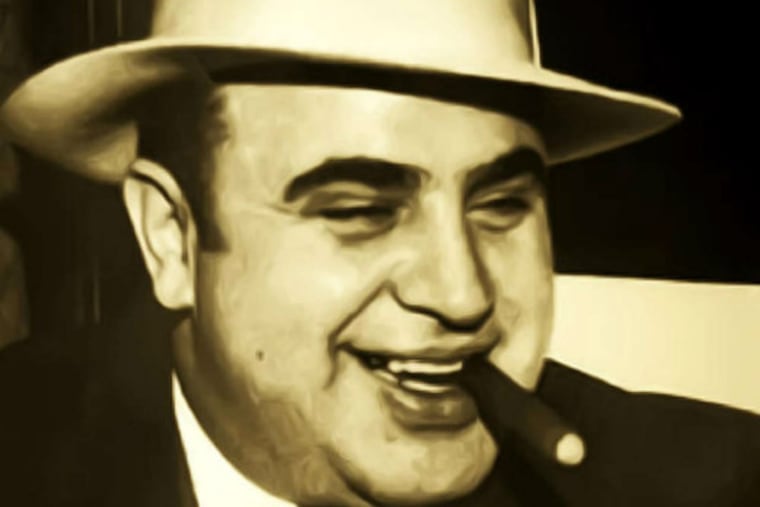Al Capone, H.H. Holmes, other notorious figures landed on 6th floor of Philly’s City Hall
The castle-like seat of Philadelphia government was also a criminal courthouse for a century until 1995, when the Criminal Justice Center opened at 13th and Filbert Streets.

The clock high on the wall in Courtroom 676 is stuck at 6:45. Every week, lawyers and mortgage counselors are there, working with homeowners to remedy pending foreclosures due to unpaid mortgages and property taxes.
But the sixth-floor room in City Hall was not always the scene of a tedious and time-consuming enterprise. It once played host to one of the most notorious criminal trials of the 19th century.
Today, City Hall is considered a place to get married, attend City Council hearings, and demonstrate outside the mayor’s office. But the castle-like seat of government was also a criminal courthouse for a century until 1995, when the Criminal Justice Center opened at 13th and Filbert Streets.
Now those courtrooms are used to resolve civil issues, making the ornate, 30-foot-high courtrooms artifacts of a rich criminal history that spanned a century. Over the years, major trials took place on other floors, but many of the most infamous cases were tried on the sixth floor.
One of the first big cases in City Hall, in 1895, was also one of the most famous cases in American history: the trial of serial killer H.H. Holmes.
Courtroom 676, like others on the floor, was adorned with gas-electric lighting fixtures called electroliers and with telephones, and a spacious visitors’ gallery opposite the judge’s bench with a seating capacity of 300. For the Holmes trial, the room was overflowing with spectators.
Holmes, real name Herman Webster Mudgett, built a “House of Horrors” in Chicago, where he tortured and murdered unsuspecting victims between 1886 and 1894. But it was not until he killed Benjamin Pitezel, a business partner in Philadelphia, that police discovered the extent of his crimes.
In the fall of 1895, Holmes went on trial in Courtroom 676 for murder in Pitezel’s death. On the first day, he dismissed his two lawyers and attempted to defend himself, but brought back the lawyers the next night. After a week, the jury found him guilty, and he was sentenced to die. He was hanged in Moyamensing Prison on May 7, 1896.
By 1929, mobster cases started heating up on the sixth floor.
“Scarface” Al Capone was arrested in Philly that May on a gun charge. Shortly after the first meeting of America’s major mob families in Atlantic City, Capone had come to Philadelphia to grab a train back to Chicago. With time to kill, he and his bodyguard, Frank “Slippery Frankie” Cline, caught a flick at the Stanley Theatre at 19th and Market Streets. When the movie let out, they were stopped by police, who frisked them and found loaded revolvers.
By the next day, in Courtroom 650, Philadelphia officials were able to charge Capone with a crime. The room, which seated about 100 people comfortably, was packed. Aspiring spectators crowded the hallway and pounded on the door. Capone and his bodyguard each pleaded guilty to a misdemeanor charge of carrying a concealed deadly weapon with the intent to “unlawfully and maliciously” do injury to another. Capone served 10 months in several jails, including Eastern State Penitentiary in Fairmount.
Five years after Capone, in 1934, serial bank robber and expert escape artist “Slick” Willie Sutton was a fugitive from New York, having recently escaped from Sing Sing Prison, when he was arrested in Philly. For his participation in a $10,800 holdup of the Corn Exchange Bank & Trust Co. branch at 60th and Ludlow Streets, Sutton was sentenced in one of the City Hall courtrooms to 25 to 50 years in prison.
After four failed attempts to escape, his fifth succeeded. He broke out along with 11 others from Eastern State in 1945. He was caught and taken to Courtroom 653, where he later stood trial for the escape. He was found guilty, and 10 to 20 years were tacked on to his previous sentence. He was sent to Holmesburg Prison, from which he escaped in 1947. When he was brought back to Philly to answer for his crimes in 1969, he was a 69-year-old man with emphysema. He was wheeled into another City Hall courtroom, where a judge showed leniency and dropped the charges.
Half a century later, the trial of Gary Heidnik took place in Courtroom 653. Heidnik was accused of kidnapping prostitutes, imprisoning them in the basement of his Franklinville home, and then torturing and sexually abusing them. In his 1988 trial, his lawyer, A. Charles Peruto Jr., told the jury panel, seated in the wood-framed jury box, that his client was simply a “fruitcake.” Heidnik was convicted of two murders and sentenced to death. In 1999, he died by lethal injection. He was 55.
Courtroom 653 also hosted two other significant cases:
Lawyers for Elmo Smith, who was found guilty of murder in the slaying of a Manayunk teenager in 1959, sought to reduce his death sentence to life imprisonment in hearings there. And then there was the 1981 trial of Joey Coyle, who found $1 million in the street and chose to spend it lavishly instead of finding its owner before being caught at a New York airport.
Today, the sixth floor is mostly quiet. George Evans, historian and City Hall tour guide, leads visitors through the mostly empty hallways and past the historic courtrooms, which primarily host civil cases. But he makes sure to remind folks about what the magnificent walls have seen.
“It’s an amazing building," Evans said, “that tells an amazing story.”
This story has been changed to correct the reference to the Elmo Smith case above. The murder case was not heard in Courtroom 653.